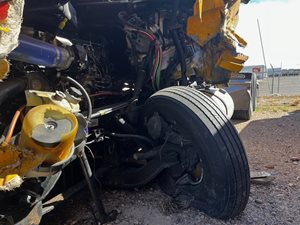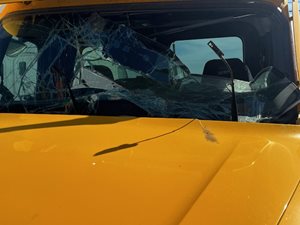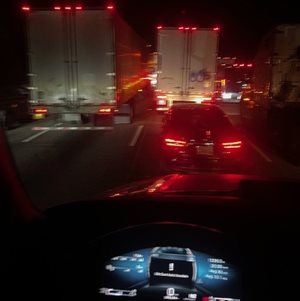

In this installment, I want to discuss my first week back to work in the new year. Not long after leaving my hometown of Laredo, Texas, I saw that a truck and trailer that had caught on fire was sitting on the southbound side of Interstate 35. The incident appeared as though it was just a truck fire with no injuries. The truck had no cab or hood. It was just the frame with an engine sticking out of it. The trailer was also melted down to the lower side rails. This did not seem like a good way for someone to start the new year. Little did I know, this was just the beginning of a continuing theme on my route this first week of 2024.
It was not much farther up I-35 that I came across another semi-truck that had been reduced to frame rails and an engine. In this case, the truck somehow exited the right side of the highway and appeared to have turned over with enough force to remove the hood, cab, and sleeper. The trailer was also a twisted pretzel. In total, I encountered four scenes where a semi-truck had been reduced to frame rails with an engine nestled between them. The scenes that I had encountered on my route had been very unsettling to me, since I make my living sitting above frame rails, much like the ones that were on the side of the highway. I realized that people must think that these incidents could never happen to them. I believe that this is often the case. My observations gave me a great deal of pause and reflection. I want to be able to arrive safely home after the end of my work cycle. But drivers in semi-trucks and cars alike, right after this incident on the highway, appeared to be racing out like horses at the starting gate of the Kentucky Derby. They were jockeying for a position that was very reminiscent of my days racing stock cars on the dirt track.
Here’s the problem though, this was not the Kentucky Derby, or for that matter, any racetrack. In my mind, I wondered “Didn’t any of these people see the damage caused to these vehicles most likely resulting from unsafe driving practices?”. When a race car driver sees a bad crash, to be competitive, there is a need to disregard the voice inside their head which, for most rational people, would say “Slow down! You could be next”. But that’s racing, where the objective is to be the first one across the finish line. What I was witnessing here was on public highways, not the racetrack.
I know that as commercial drivers we talk about four-wheelers’ bad driving, and the rest of the motoring public talks about semi-trucks the same way. I say, “Let’s stop pointing fingers at each other. Let everyone learn to drive in a way that will cause fewer delays on the highway. Time lost in crashes should never be made up by increasing speeds afterward to try to get to a destination in time. Instead, we should all drive safely to avoid crashing or, if possible, start the journey earlier.”
As I continued this trip, there was a major crash on Interstate 285 which is the loop around Atlanta, Georgia. While sitting there for the better part of two hours, I saw that there was a second crash that involved seven cars that were totaled. The second crash seemed to have been caused by people not reacting properly to the initial crash. After getting around this crash, cars and trucks once again drove off in a manner like they had not even seen any problem.
In my Cascadia, the dash displays the speed of vehicles as they enter the lane in front of me. The speed limit on Atlanta’s I-285 loop is 65 mph. Not long ago these speeds would have been unheard of in an urban setting. However, those speeds are evidently nowhere near what other highway users feel that they need to accomplish as goals in their journey. The speed indicator on my dash kept reading speeds over 100 mph!! This is ridiculous in my opinion. At 100 mph, reaction times must be at a level that is required in a sanctioned competitive event, not the public highway. But I keep coming back to “Do these people not see what just happened back there?”.
On the journey home, there was another incident on I-10 that stopped traffic due to a crash. Once again, after emerging on the other side of the destroyed vehicles, people started driving aggressively while on I-10 in downtown Houston, Texas. One of these vehicles was a tractor-trailer that came by me pulling a cattle trailer at 89 mph. Right after that, I had another semi pass me at 75 mph while pulling a set of double trailers. I think this second truck would have tried to keep up with the cattle hauler, but I believe they had a governed speedometer that was set at 75 mph. Let’s think about how much time is lost on the highway due to crashes that were caused by drivers who were trying to make better time.
Often, in construction zones, the lanes are shifting or are narrower, with less room to escape an errant maneuver from another motorist. In South Carolina, a towing business seized the opportunity and opened a yard that is in a field directly adjacent to Interstate 85. In this area from Spartanburg to Blacksburg, there are many crashes regularly. This towing business has realized that this large area is usually filled with semi-trucks and trailers that do not navigate this treacherous construction zone safely. In this construction zone, which has a speed limit varying between 45 to 55 mph, I regularly see speeds above 75 mph.
I treat this construction zone much like the advice that was given to me by an old-timer years ago. It was “You can go down a mountain thousands of times too slow, but you can only go down a mountain once too fast.” With all the billboards of lawyers with lawsuits that are along the highway, a driver should pause and think about the way they are driving after these crashes. The only thing that I can figure out is that it will never happen to them. Yes! It can happen to you as evidenced by the hours I spent sitting still on the interstate while these incidents were being cleared.
In this article, take notice that I did not once call these incidents “accidents”. They are crashes caused by inattentive driving, aggressive driving, or some other selfish, careless act. Obey speed limits. Watch for traffic slowing down in construction zones and slow down to the posted speed limit in that area. We all want to get home safely and on time. Drive safe out there.
